Managing Organizations: A Report on Motivation Theories
VerifiedAdded on 2023/06/12
|9
|3046
|159
Report
AI Summary
This report provides an analysis of motivation theories and their application in modern organizations. It begins by defining motivation as a managerial process that stimulates employees to achieve maximum productivity, discussing its features and importance in achieving organizational goals. The report then delves into three major motivation theories: Maslow's hierarchy of needs, Herzberg's two-factor theory, and Goal theory. Maslow's theory outlines five levels of needs, from physiological to self-actualization, while Herzberg's theory distinguishes between motivating and hygiene factors affecting job satisfaction. Goal theory emphasizes the importance of setting clear and specific goals to enhance motivation and productivity. The report evaluates the use of Maslow's and Goal theories in contemporary organizations, highlighting their benefits and potential negative impacts. Empirical evidence from companies like Tesco, Sainsbury's and Unilever illustrates the practical application of these theories in fostering employee motivation and achieving organizational objectives. The conclusion reinforces the significance of motivation in driving organizational success and the strategic use of motivation theories in modern management practices.
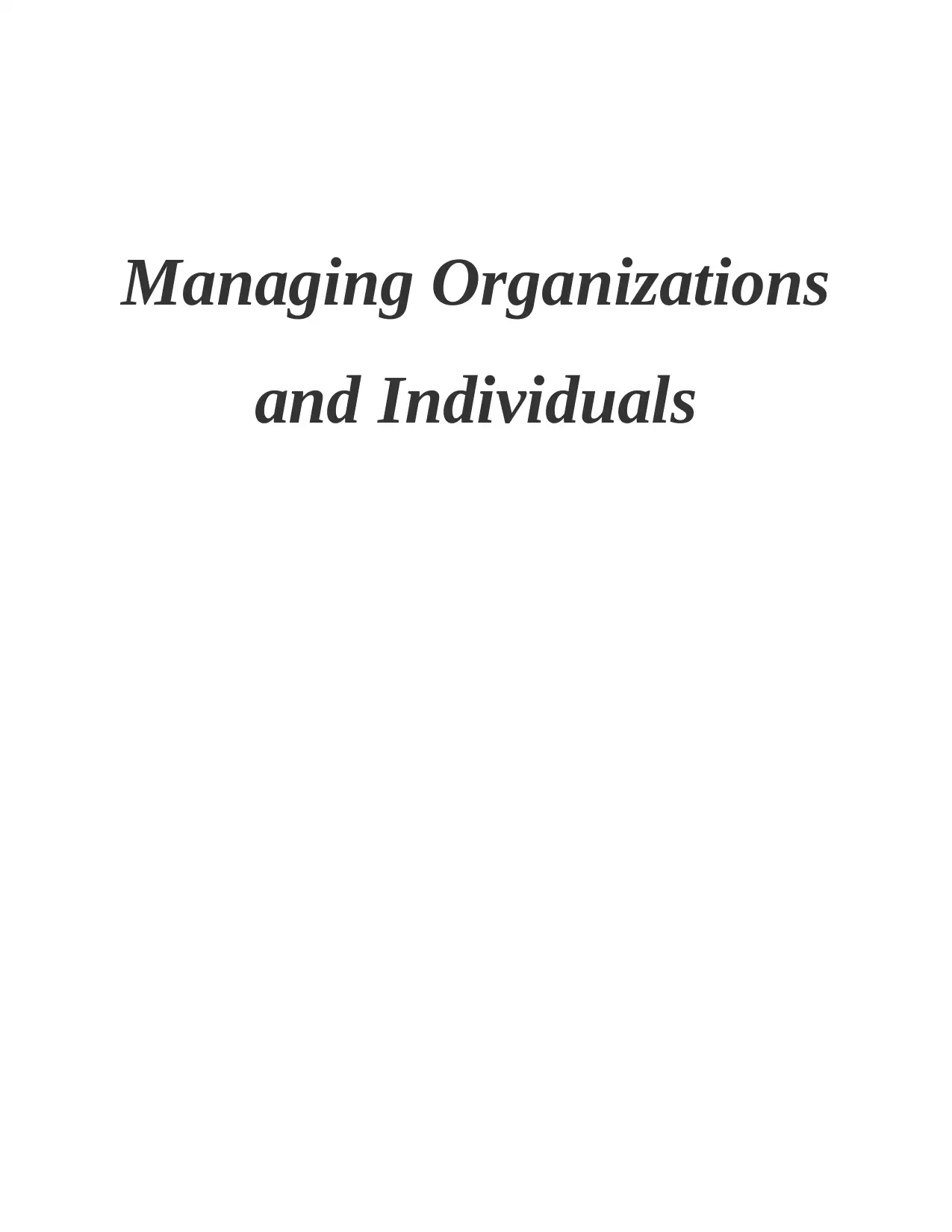
Managing Organizations
and Individuals
and Individuals
Paraphrase This Document
Need a fresh take? Get an instant paraphrase of this document with our AI Paraphraser
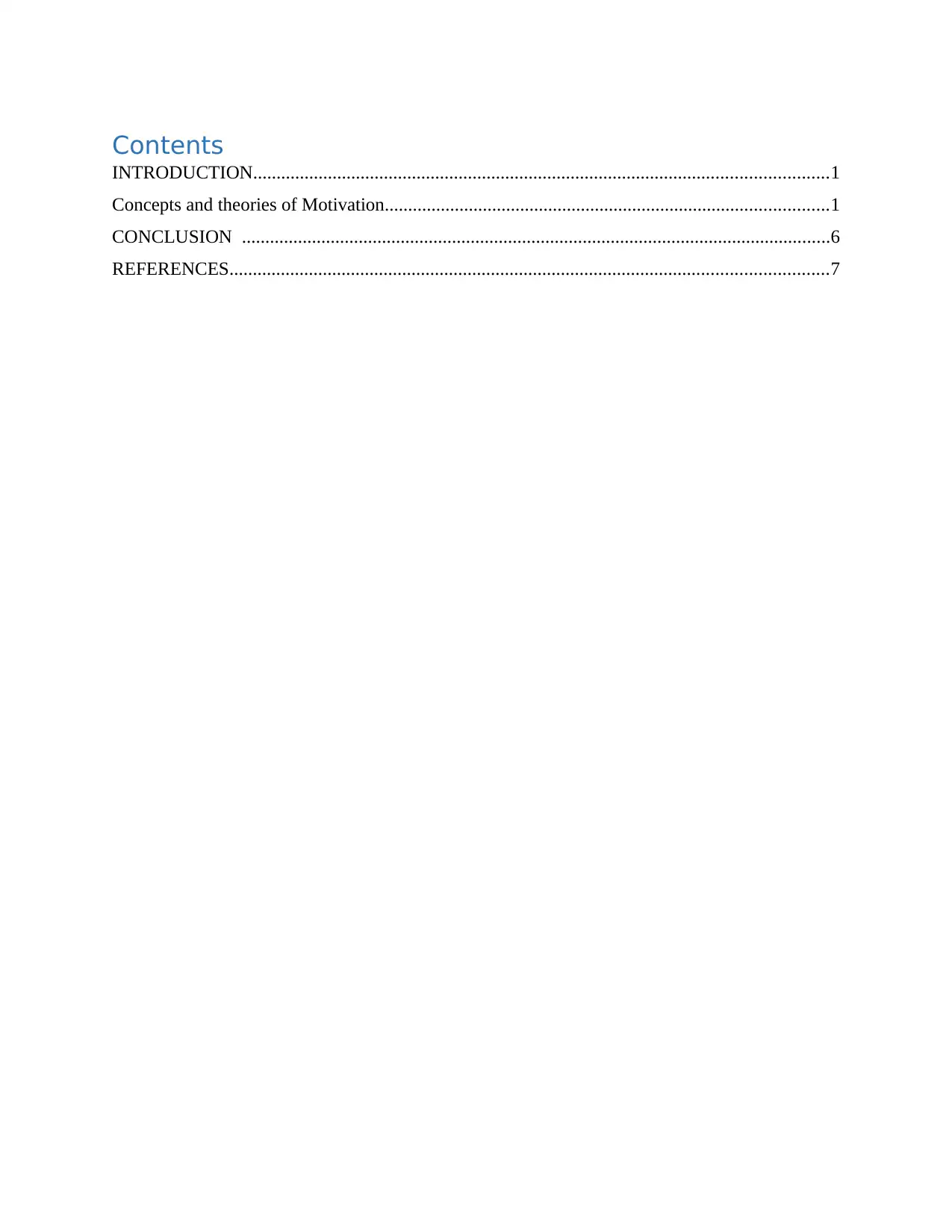
Contents
INTRODUCTION...........................................................................................................................1
Concepts and theories of Motivation...............................................................................................1
CONCLUSION ..............................................................................................................................6
REFERENCES................................................................................................................................7
INTRODUCTION...........................................................................................................................1
Concepts and theories of Motivation...............................................................................................1
CONCLUSION ..............................................................................................................................6
REFERENCES................................................................................................................................7
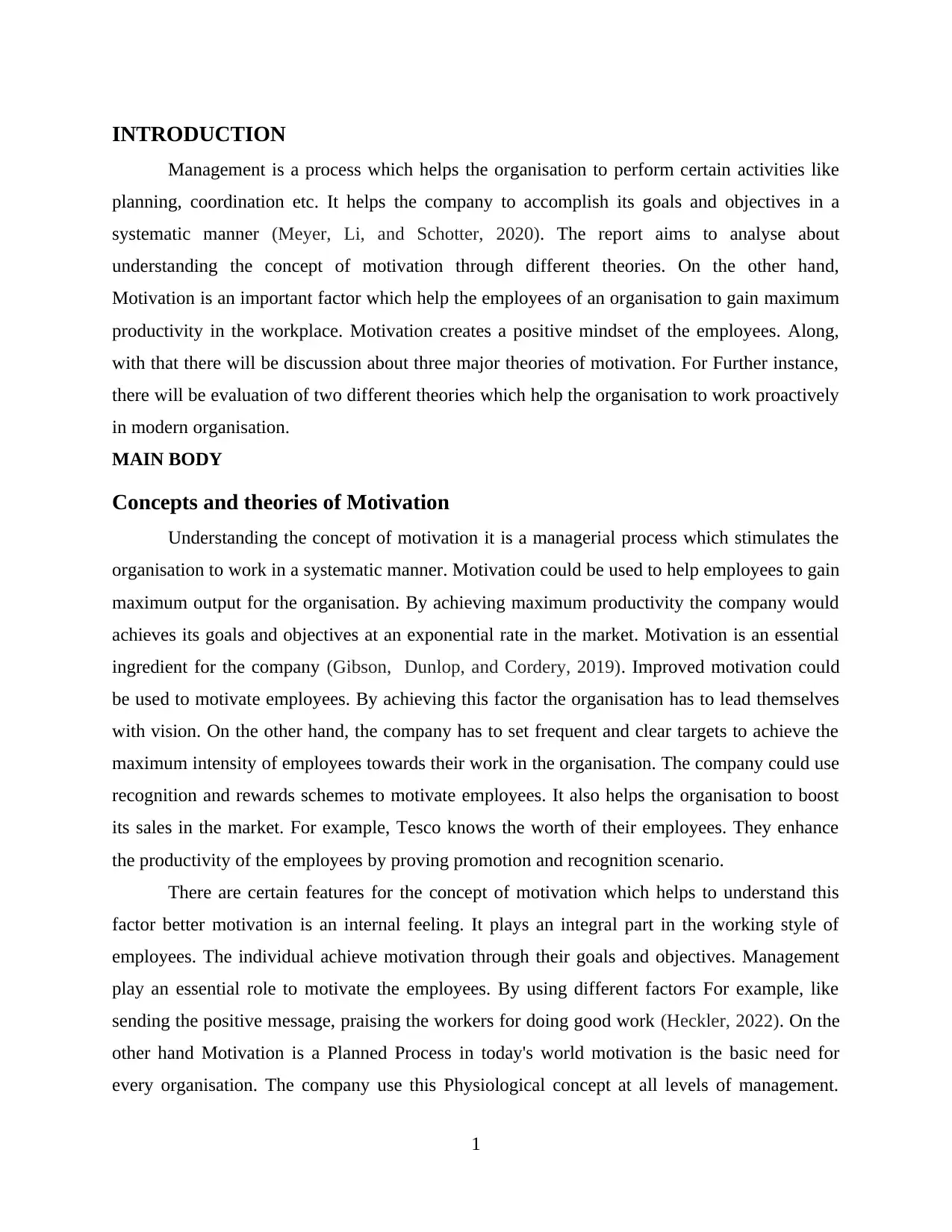
INTRODUCTION
Management is a process which helps the organisation to perform certain activities like
planning, coordination etc. It helps the company to accomplish its goals and objectives in a
systematic manner (Meyer, Li, and Schotter, 2020). The report aims to analyse about
understanding the concept of motivation through different theories. On the other hand,
Motivation is an important factor which help the employees of an organisation to gain maximum
productivity in the workplace. Motivation creates a positive mindset of the employees. Along,
with that there will be discussion about three major theories of motivation. For Further instance,
there will be evaluation of two different theories which help the organisation to work proactively
in modern organisation.
MAIN BODY
Concepts and theories of Motivation
Understanding the concept of motivation it is a managerial process which stimulates the
organisation to work in a systematic manner. Motivation could be used to help employees to gain
maximum output for the organisation. By achieving maximum productivity the company would
achieves its goals and objectives at an exponential rate in the market. Motivation is an essential
ingredient for the company (Gibson, Dunlop, and Cordery, 2019). Improved motivation could
be used to motivate employees. By achieving this factor the organisation has to lead themselves
with vision. On the other hand, the company has to set frequent and clear targets to achieve the
maximum intensity of employees towards their work in the organisation. The company could use
recognition and rewards schemes to motivate employees. It also helps the organisation to boost
its sales in the market. For example, Tesco knows the worth of their employees. They enhance
the productivity of the employees by proving promotion and recognition scenario.
There are certain features for the concept of motivation which helps to understand this
factor better motivation is an internal feeling. It plays an integral part in the working style of
employees. The individual achieve motivation through their goals and objectives. Management
play an essential role to motivate the employees. By using different factors For example, like
sending the positive message, praising the workers for doing good work (Heckler, 2022). On the
other hand Motivation is a Planned Process in today's world motivation is the basic need for
every organisation. The company use this Physiological concept at all levels of management.
1
Management is a process which helps the organisation to perform certain activities like
planning, coordination etc. It helps the company to accomplish its goals and objectives in a
systematic manner (Meyer, Li, and Schotter, 2020). The report aims to analyse about
understanding the concept of motivation through different theories. On the other hand,
Motivation is an important factor which help the employees of an organisation to gain maximum
productivity in the workplace. Motivation creates a positive mindset of the employees. Along,
with that there will be discussion about three major theories of motivation. For Further instance,
there will be evaluation of two different theories which help the organisation to work proactively
in modern organisation.
MAIN BODY
Concepts and theories of Motivation
Understanding the concept of motivation it is a managerial process which stimulates the
organisation to work in a systematic manner. Motivation could be used to help employees to gain
maximum output for the organisation. By achieving maximum productivity the company would
achieves its goals and objectives at an exponential rate in the market. Motivation is an essential
ingredient for the company (Gibson, Dunlop, and Cordery, 2019). Improved motivation could
be used to motivate employees. By achieving this factor the organisation has to lead themselves
with vision. On the other hand, the company has to set frequent and clear targets to achieve the
maximum intensity of employees towards their work in the organisation. The company could use
recognition and rewards schemes to motivate employees. It also helps the organisation to boost
its sales in the market. For example, Tesco knows the worth of their employees. They enhance
the productivity of the employees by proving promotion and recognition scenario.
There are certain features for the concept of motivation which helps to understand this
factor better motivation is an internal feeling. It plays an integral part in the working style of
employees. The individual achieve motivation through their goals and objectives. Management
play an essential role to motivate the employees. By using different factors For example, like
sending the positive message, praising the workers for doing good work (Heckler, 2022). On the
other hand Motivation is a Planned Process in today's world motivation is the basic need for
every organisation. The company use this Physiological concept at all levels of management.
1
⊘ This is a preview!⊘
Do you want full access?
Subscribe today to unlock all pages.

Trusted by 1+ million students worldwide
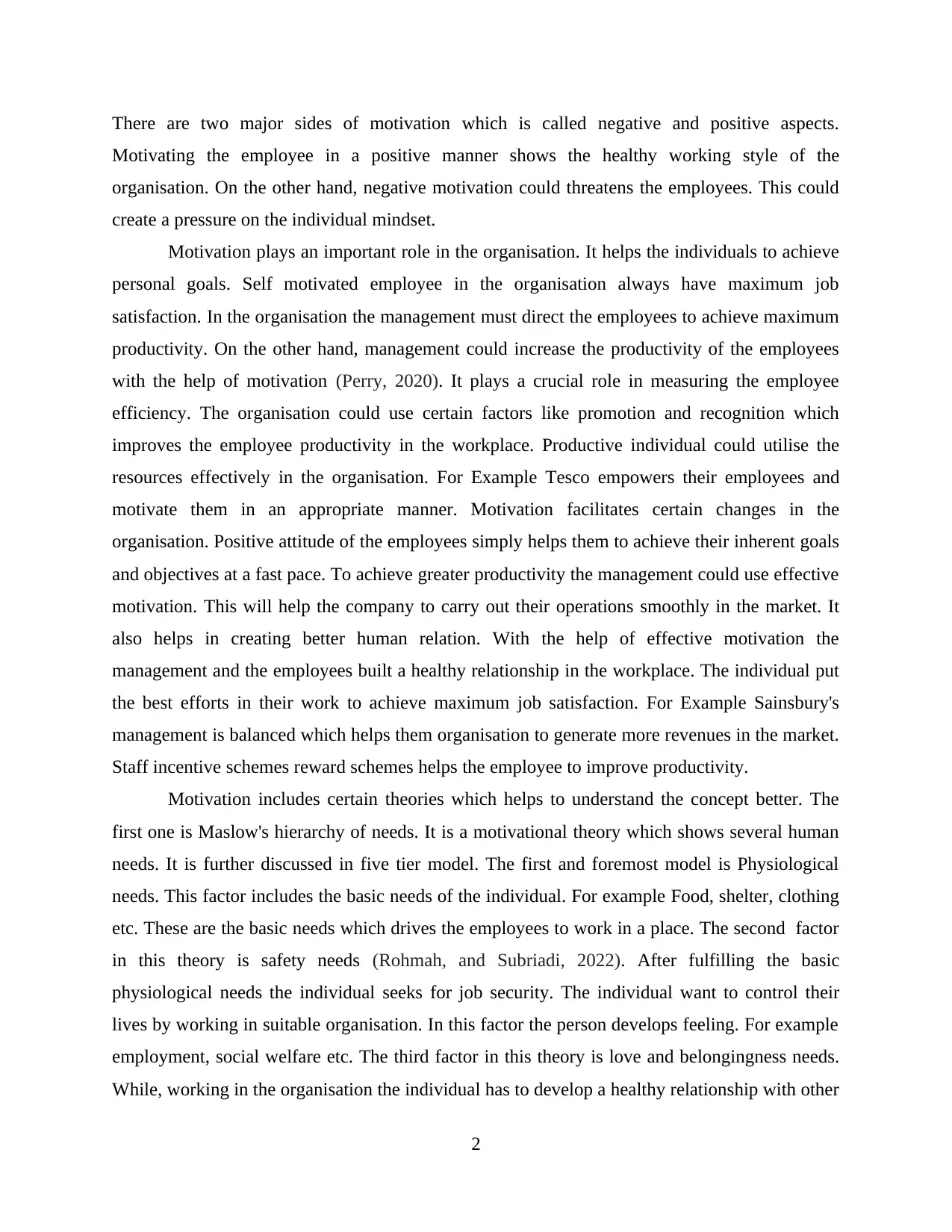
There are two major sides of motivation which is called negative and positive aspects.
Motivating the employee in a positive manner shows the healthy working style of the
organisation. On the other hand, negative motivation could threatens the employees. This could
create a pressure on the individual mindset.
Motivation plays an important role in the organisation. It helps the individuals to achieve
personal goals. Self motivated employee in the organisation always have maximum job
satisfaction. In the organisation the management must direct the employees to achieve maximum
productivity. On the other hand, management could increase the productivity of the employees
with the help of motivation (Perry, 2020). It plays a crucial role in measuring the employee
efficiency. The organisation could use certain factors like promotion and recognition which
improves the employee productivity in the workplace. Productive individual could utilise the
resources effectively in the organisation. For Example Tesco empowers their employees and
motivate them in an appropriate manner. Motivation facilitates certain changes in the
organisation. Positive attitude of the employees simply helps them to achieve their inherent goals
and objectives at a fast pace. To achieve greater productivity the management could use effective
motivation. This will help the company to carry out their operations smoothly in the market. It
also helps in creating better human relation. With the help of effective motivation the
management and the employees built a healthy relationship in the workplace. The individual put
the best efforts in their work to achieve maximum job satisfaction. For Example Sainsbury's
management is balanced which helps them organisation to generate more revenues in the market.
Staff incentive schemes reward schemes helps the employee to improve productivity.
Motivation includes certain theories which helps to understand the concept better. The
first one is Maslow's hierarchy of needs. It is a motivational theory which shows several human
needs. It is further discussed in five tier model. The first and foremost model is Physiological
needs. This factor includes the basic needs of the individual. For example Food, shelter, clothing
etc. These are the basic needs which drives the employees to work in a place. The second factor
in this theory is safety needs (Rohmah, and Subriadi, 2022). After fulfilling the basic
physiological needs the individual seeks for job security. The individual want to control their
lives by working in suitable organisation. In this factor the person develops feeling. For example
employment, social welfare etc. The third factor in this theory is love and belongingness needs.
While, working in the organisation the individual has to develop a healthy relationship with other
2
Motivating the employee in a positive manner shows the healthy working style of the
organisation. On the other hand, negative motivation could threatens the employees. This could
create a pressure on the individual mindset.
Motivation plays an important role in the organisation. It helps the individuals to achieve
personal goals. Self motivated employee in the organisation always have maximum job
satisfaction. In the organisation the management must direct the employees to achieve maximum
productivity. On the other hand, management could increase the productivity of the employees
with the help of motivation (Perry, 2020). It plays a crucial role in measuring the employee
efficiency. The organisation could use certain factors like promotion and recognition which
improves the employee productivity in the workplace. Productive individual could utilise the
resources effectively in the organisation. For Example Tesco empowers their employees and
motivate them in an appropriate manner. Motivation facilitates certain changes in the
organisation. Positive attitude of the employees simply helps them to achieve their inherent goals
and objectives at a fast pace. To achieve greater productivity the management could use effective
motivation. This will help the company to carry out their operations smoothly in the market. It
also helps in creating better human relation. With the help of effective motivation the
management and the employees built a healthy relationship in the workplace. The individual put
the best efforts in their work to achieve maximum job satisfaction. For Example Sainsbury's
management is balanced which helps them organisation to generate more revenues in the market.
Staff incentive schemes reward schemes helps the employee to improve productivity.
Motivation includes certain theories which helps to understand the concept better. The
first one is Maslow's hierarchy of needs. It is a motivational theory which shows several human
needs. It is further discussed in five tier model. The first and foremost model is Physiological
needs. This factor includes the basic needs of the individual. For example Food, shelter, clothing
etc. These are the basic needs which drives the employees to work in a place. The second factor
in this theory is safety needs (Rohmah, and Subriadi, 2022). After fulfilling the basic
physiological needs the individual seeks for job security. The individual want to control their
lives by working in suitable organisation. In this factor the person develops feeling. For example
employment, social welfare etc. The third factor in this theory is love and belongingness needs.
While, working in the organisation the individual has to develop a healthy relationship with other
2
Paraphrase This Document
Need a fresh take? Get an instant paraphrase of this document with our AI Paraphraser
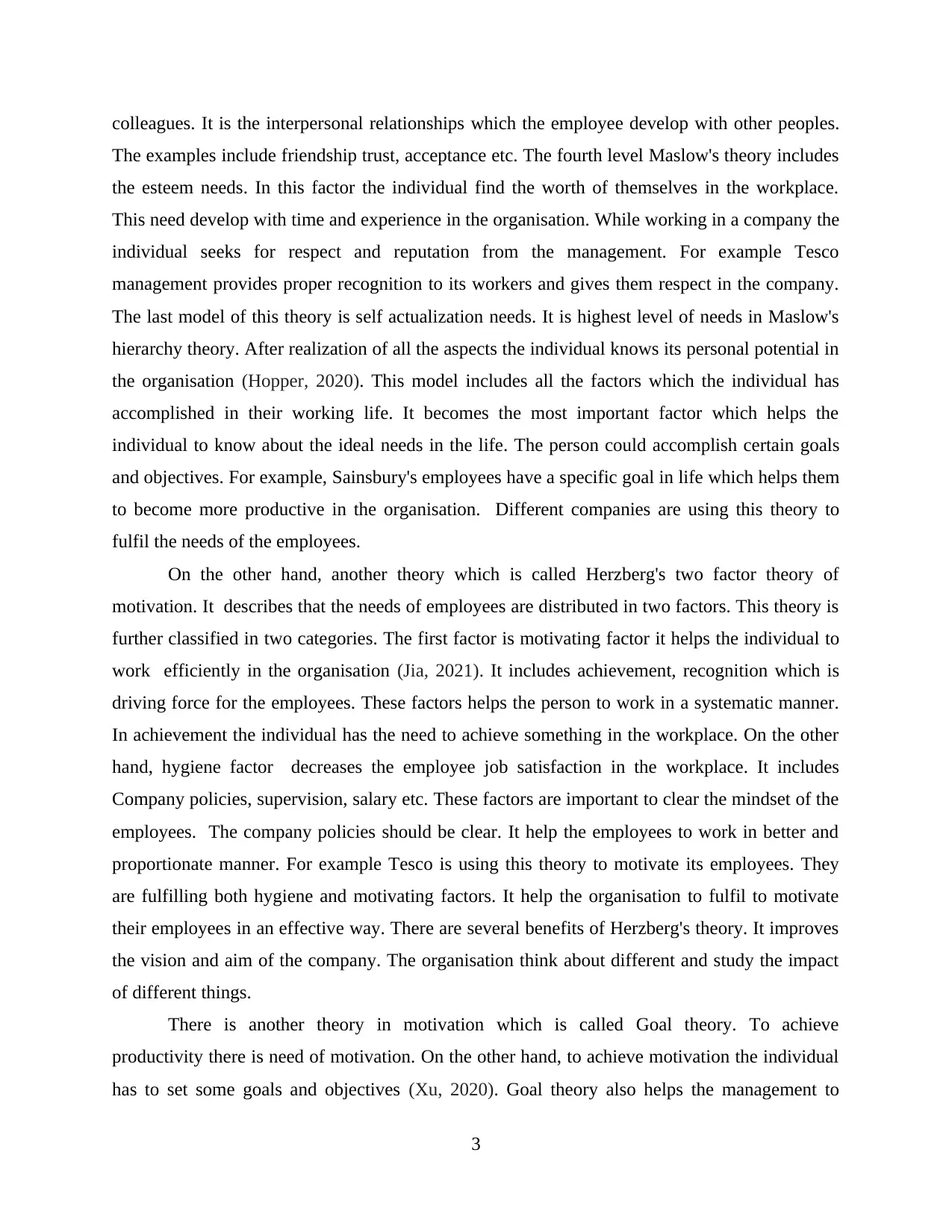
colleagues. It is the interpersonal relationships which the employee develop with other peoples.
The examples include friendship trust, acceptance etc. The fourth level Maslow's theory includes
the esteem needs. In this factor the individual find the worth of themselves in the workplace.
This need develop with time and experience in the organisation. While working in a company the
individual seeks for respect and reputation from the management. For example Tesco
management provides proper recognition to its workers and gives them respect in the company.
The last model of this theory is self actualization needs. It is highest level of needs in Maslow's
hierarchy theory. After realization of all the aspects the individual knows its personal potential in
the organisation (Hopper, 2020). This model includes all the factors which the individual has
accomplished in their working life. It becomes the most important factor which helps the
individual to know about the ideal needs in the life. The person could accomplish certain goals
and objectives. For example, Sainsbury's employees have a specific goal in life which helps them
to become more productive in the organisation. Different companies are using this theory to
fulfil the needs of the employees.
On the other hand, another theory which is called Herzberg's two factor theory of
motivation. It describes that the needs of employees are distributed in two factors. This theory is
further classified in two categories. The first factor is motivating factor it helps the individual to
work efficiently in the organisation (Jia, 2021). It includes achievement, recognition which is
driving force for the employees. These factors helps the person to work in a systematic manner.
In achievement the individual has the need to achieve something in the workplace. On the other
hand, hygiene factor decreases the employee job satisfaction in the workplace. It includes
Company policies, supervision, salary etc. These factors are important to clear the mindset of the
employees. The company policies should be clear. It help the employees to work in better and
proportionate manner. For example Tesco is using this theory to motivate its employees. They
are fulfilling both hygiene and motivating factors. It help the organisation to fulfil to motivate
their employees in an effective way. There are several benefits of Herzberg's theory. It improves
the vision and aim of the company. The organisation think about different and study the impact
of different things.
There is another theory in motivation which is called Goal theory. To achieve
productivity there is need of motivation. On the other hand, to achieve motivation the individual
has to set some goals and objectives (Xu, 2020). Goal theory also helps the management to
3
The examples include friendship trust, acceptance etc. The fourth level Maslow's theory includes
the esteem needs. In this factor the individual find the worth of themselves in the workplace.
This need develop with time and experience in the organisation. While working in a company the
individual seeks for respect and reputation from the management. For example Tesco
management provides proper recognition to its workers and gives them respect in the company.
The last model of this theory is self actualization needs. It is highest level of needs in Maslow's
hierarchy theory. After realization of all the aspects the individual knows its personal potential in
the organisation (Hopper, 2020). This model includes all the factors which the individual has
accomplished in their working life. It becomes the most important factor which helps the
individual to know about the ideal needs in the life. The person could accomplish certain goals
and objectives. For example, Sainsbury's employees have a specific goal in life which helps them
to become more productive in the organisation. Different companies are using this theory to
fulfil the needs of the employees.
On the other hand, another theory which is called Herzberg's two factor theory of
motivation. It describes that the needs of employees are distributed in two factors. This theory is
further classified in two categories. The first factor is motivating factor it helps the individual to
work efficiently in the organisation (Jia, 2021). It includes achievement, recognition which is
driving force for the employees. These factors helps the person to work in a systematic manner.
In achievement the individual has the need to achieve something in the workplace. On the other
hand, hygiene factor decreases the employee job satisfaction in the workplace. It includes
Company policies, supervision, salary etc. These factors are important to clear the mindset of the
employees. The company policies should be clear. It help the employees to work in better and
proportionate manner. For example Tesco is using this theory to motivate its employees. They
are fulfilling both hygiene and motivating factors. It help the organisation to fulfil to motivate
their employees in an effective way. There are several benefits of Herzberg's theory. It improves
the vision and aim of the company. The organisation think about different and study the impact
of different things.
There is another theory in motivation which is called Goal theory. To achieve
productivity there is need of motivation. On the other hand, to achieve motivation the individual
has to set some goals and objectives (Xu, 2020). Goal theory also helps the management to
3
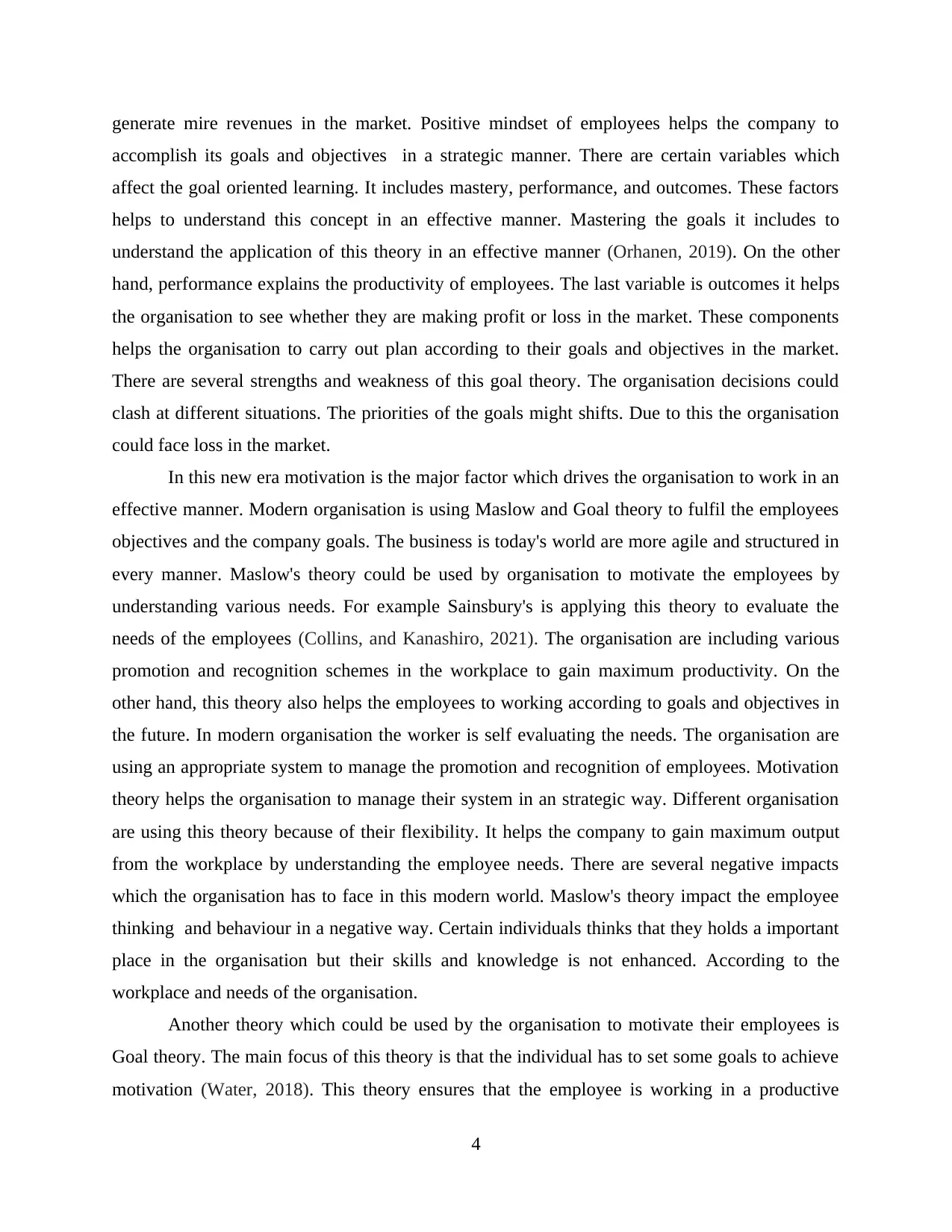
generate mire revenues in the market. Positive mindset of employees helps the company to
accomplish its goals and objectives in a strategic manner. There are certain variables which
affect the goal oriented learning. It includes mastery, performance, and outcomes. These factors
helps to understand this concept in an effective manner. Mastering the goals it includes to
understand the application of this theory in an effective manner (Orhanen, 2019). On the other
hand, performance explains the productivity of employees. The last variable is outcomes it helps
the organisation to see whether they are making profit or loss in the market. These components
helps the organisation to carry out plan according to their goals and objectives in the market.
There are several strengths and weakness of this goal theory. The organisation decisions could
clash at different situations. The priorities of the goals might shifts. Due to this the organisation
could face loss in the market.
In this new era motivation is the major factor which drives the organisation to work in an
effective manner. Modern organisation is using Maslow and Goal theory to fulfil the employees
objectives and the company goals. The business is today's world are more agile and structured in
every manner. Maslow's theory could be used by organisation to motivate the employees by
understanding various needs. For example Sainsbury's is applying this theory to evaluate the
needs of the employees (Collins, and Kanashiro, 2021). The organisation are including various
promotion and recognition schemes in the workplace to gain maximum productivity. On the
other hand, this theory also helps the employees to working according to goals and objectives in
the future. In modern organisation the worker is self evaluating the needs. The organisation are
using an appropriate system to manage the promotion and recognition of employees. Motivation
theory helps the organisation to manage their system in an strategic way. Different organisation
are using this theory because of their flexibility. It helps the company to gain maximum output
from the workplace by understanding the employee needs. There are several negative impacts
which the organisation has to face in this modern world. Maslow's theory impact the employee
thinking and behaviour in a negative way. Certain individuals thinks that they holds a important
place in the organisation but their skills and knowledge is not enhanced. According to the
workplace and needs of the organisation.
Another theory which could be used by the organisation to motivate their employees is
Goal theory. The main focus of this theory is that the individual has to set some goals to achieve
motivation (Water, 2018). This theory ensures that the employee is working in a productive
4
accomplish its goals and objectives in a strategic manner. There are certain variables which
affect the goal oriented learning. It includes mastery, performance, and outcomes. These factors
helps to understand this concept in an effective manner. Mastering the goals it includes to
understand the application of this theory in an effective manner (Orhanen, 2019). On the other
hand, performance explains the productivity of employees. The last variable is outcomes it helps
the organisation to see whether they are making profit or loss in the market. These components
helps the organisation to carry out plan according to their goals and objectives in the market.
There are several strengths and weakness of this goal theory. The organisation decisions could
clash at different situations. The priorities of the goals might shifts. Due to this the organisation
could face loss in the market.
In this new era motivation is the major factor which drives the organisation to work in an
effective manner. Modern organisation is using Maslow and Goal theory to fulfil the employees
objectives and the company goals. The business is today's world are more agile and structured in
every manner. Maslow's theory could be used by organisation to motivate the employees by
understanding various needs. For example Sainsbury's is applying this theory to evaluate the
needs of the employees (Collins, and Kanashiro, 2021). The organisation are including various
promotion and recognition schemes in the workplace to gain maximum productivity. On the
other hand, this theory also helps the employees to working according to goals and objectives in
the future. In modern organisation the worker is self evaluating the needs. The organisation are
using an appropriate system to manage the promotion and recognition of employees. Motivation
theory helps the organisation to manage their system in an strategic way. Different organisation
are using this theory because of their flexibility. It helps the company to gain maximum output
from the workplace by understanding the employee needs. There are several negative impacts
which the organisation has to face in this modern world. Maslow's theory impact the employee
thinking and behaviour in a negative way. Certain individuals thinks that they holds a important
place in the organisation but their skills and knowledge is not enhanced. According to the
workplace and needs of the organisation.
Another theory which could be used by the organisation to motivate their employees is
Goal theory. The main focus of this theory is that the individual has to set some goals to achieve
motivation (Water, 2018). This theory ensures that the employee is working in a productive
4
⊘ This is a preview!⊘
Do you want full access?
Subscribe today to unlock all pages.

Trusted by 1+ million students worldwide
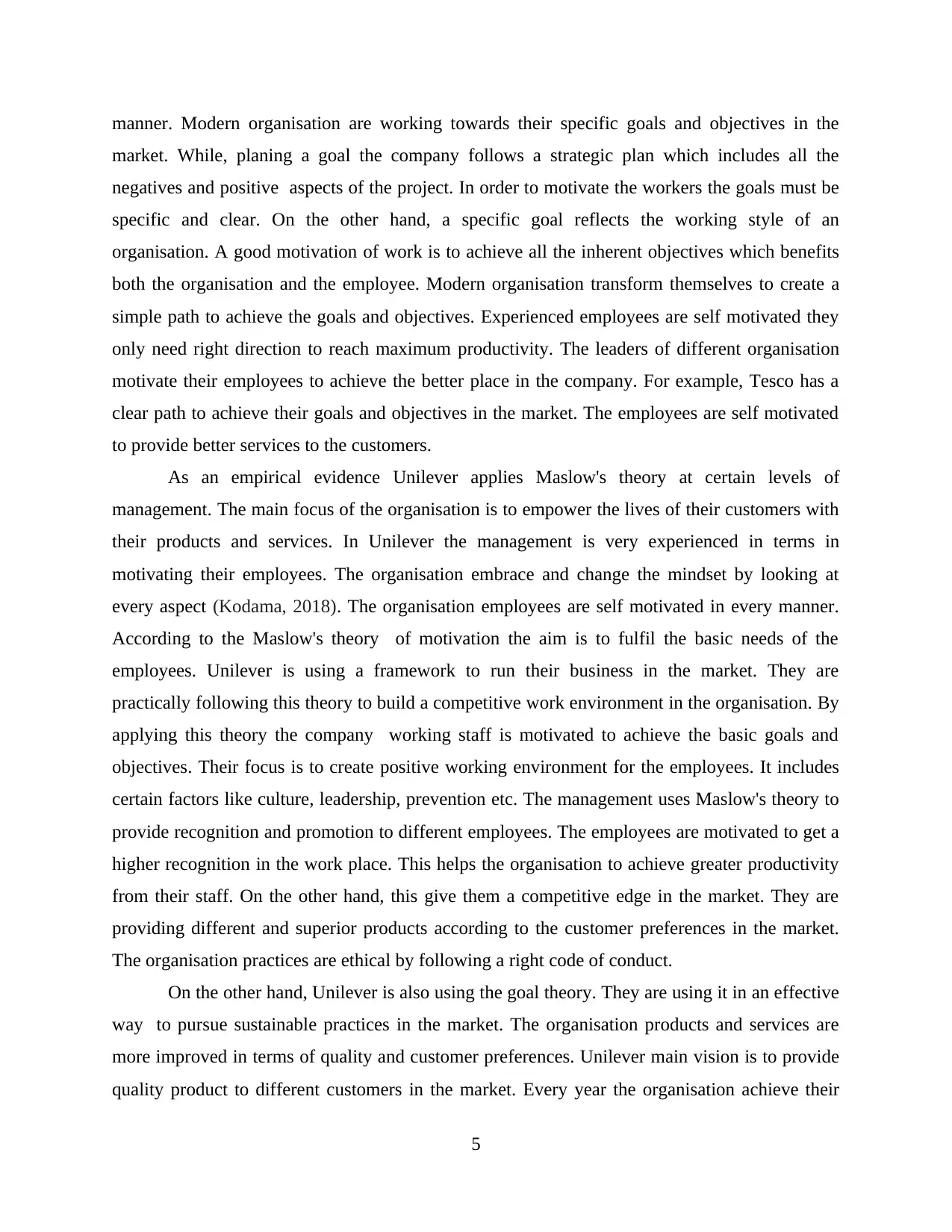
manner. Modern organisation are working towards their specific goals and objectives in the
market. While, planing a goal the company follows a strategic plan which includes all the
negatives and positive aspects of the project. In order to motivate the workers the goals must be
specific and clear. On the other hand, a specific goal reflects the working style of an
organisation. A good motivation of work is to achieve all the inherent objectives which benefits
both the organisation and the employee. Modern organisation transform themselves to create a
simple path to achieve the goals and objectives. Experienced employees are self motivated they
only need right direction to reach maximum productivity. The leaders of different organisation
motivate their employees to achieve the better place in the company. For example, Tesco has a
clear path to achieve their goals and objectives in the market. The employees are self motivated
to provide better services to the customers.
As an empirical evidence Unilever applies Maslow's theory at certain levels of
management. The main focus of the organisation is to empower the lives of their customers with
their products and services. In Unilever the management is very experienced in terms in
motivating their employees. The organisation embrace and change the mindset by looking at
every aspect (Kodama, 2018). The organisation employees are self motivated in every manner.
According to the Maslow's theory of motivation the aim is to fulfil the basic needs of the
employees. Unilever is using a framework to run their business in the market. They are
practically following this theory to build a competitive work environment in the organisation. By
applying this theory the company working staff is motivated to achieve the basic goals and
objectives. Their focus is to create positive working environment for the employees. It includes
certain factors like culture, leadership, prevention etc. The management uses Maslow's theory to
provide recognition and promotion to different employees. The employees are motivated to get a
higher recognition in the work place. This helps the organisation to achieve greater productivity
from their staff. On the other hand, this give them a competitive edge in the market. They are
providing different and superior products according to the customer preferences in the market.
The organisation practices are ethical by following a right code of conduct.
On the other hand, Unilever is also using the goal theory. They are using it in an effective
way to pursue sustainable practices in the market. The organisation products and services are
more improved in terms of quality and customer preferences. Unilever main vision is to provide
quality product to different customers in the market. Every year the organisation achieve their
5
market. While, planing a goal the company follows a strategic plan which includes all the
negatives and positive aspects of the project. In order to motivate the workers the goals must be
specific and clear. On the other hand, a specific goal reflects the working style of an
organisation. A good motivation of work is to achieve all the inherent objectives which benefits
both the organisation and the employee. Modern organisation transform themselves to create a
simple path to achieve the goals and objectives. Experienced employees are self motivated they
only need right direction to reach maximum productivity. The leaders of different organisation
motivate their employees to achieve the better place in the company. For example, Tesco has a
clear path to achieve their goals and objectives in the market. The employees are self motivated
to provide better services to the customers.
As an empirical evidence Unilever applies Maslow's theory at certain levels of
management. The main focus of the organisation is to empower the lives of their customers with
their products and services. In Unilever the management is very experienced in terms in
motivating their employees. The organisation embrace and change the mindset by looking at
every aspect (Kodama, 2018). The organisation employees are self motivated in every manner.
According to the Maslow's theory of motivation the aim is to fulfil the basic needs of the
employees. Unilever is using a framework to run their business in the market. They are
practically following this theory to build a competitive work environment in the organisation. By
applying this theory the company working staff is motivated to achieve the basic goals and
objectives. Their focus is to create positive working environment for the employees. It includes
certain factors like culture, leadership, prevention etc. The management uses Maslow's theory to
provide recognition and promotion to different employees. The employees are motivated to get a
higher recognition in the work place. This helps the organisation to achieve greater productivity
from their staff. On the other hand, this give them a competitive edge in the market. They are
providing different and superior products according to the customer preferences in the market.
The organisation practices are ethical by following a right code of conduct.
On the other hand, Unilever is also using the goal theory. They are using it in an effective
way to pursue sustainable practices in the market. The organisation products and services are
more improved in terms of quality and customer preferences. Unilever main vision is to provide
quality product to different customers in the market. Every year the organisation achieve their
5
Paraphrase This Document
Need a fresh take? Get an instant paraphrase of this document with our AI Paraphraser
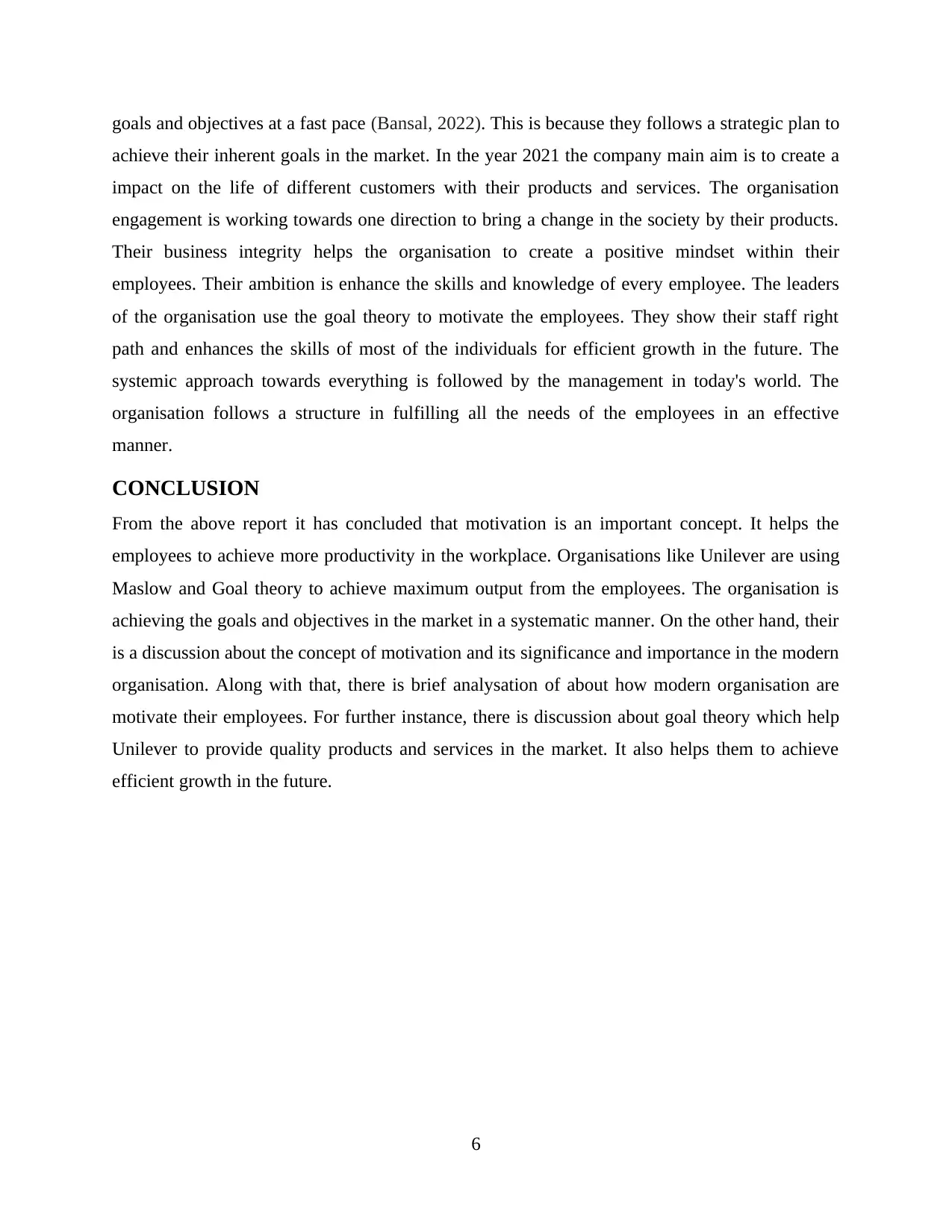
goals and objectives at a fast pace (Bansal, 2022). This is because they follows a strategic plan to
achieve their inherent goals in the market. In the year 2021 the company main aim is to create a
impact on the life of different customers with their products and services. The organisation
engagement is working towards one direction to bring a change in the society by their products.
Their business integrity helps the organisation to create a positive mindset within their
employees. Their ambition is enhance the skills and knowledge of every employee. The leaders
of the organisation use the goal theory to motivate the employees. They show their staff right
path and enhances the skills of most of the individuals for efficient growth in the future. The
systemic approach towards everything is followed by the management in today's world. The
organisation follows a structure in fulfilling all the needs of the employees in an effective
manner.
CONCLUSION
From the above report it has concluded that motivation is an important concept. It helps the
employees to achieve more productivity in the workplace. Organisations like Unilever are using
Maslow and Goal theory to achieve maximum output from the employees. The organisation is
achieving the goals and objectives in the market in a systematic manner. On the other hand, their
is a discussion about the concept of motivation and its significance and importance in the modern
organisation. Along with that, there is brief analysation of about how modern organisation are
motivate their employees. For further instance, there is discussion about goal theory which help
Unilever to provide quality products and services in the market. It also helps them to achieve
efficient growth in the future.
6
achieve their inherent goals in the market. In the year 2021 the company main aim is to create a
impact on the life of different customers with their products and services. The organisation
engagement is working towards one direction to bring a change in the society by their products.
Their business integrity helps the organisation to create a positive mindset within their
employees. Their ambition is enhance the skills and knowledge of every employee. The leaders
of the organisation use the goal theory to motivate the employees. They show their staff right
path and enhances the skills of most of the individuals for efficient growth in the future. The
systemic approach towards everything is followed by the management in today's world. The
organisation follows a structure in fulfilling all the needs of the employees in an effective
manner.
CONCLUSION
From the above report it has concluded that motivation is an important concept. It helps the
employees to achieve more productivity in the workplace. Organisations like Unilever are using
Maslow and Goal theory to achieve maximum output from the employees. The organisation is
achieving the goals and objectives in the market in a systematic manner. On the other hand, their
is a discussion about the concept of motivation and its significance and importance in the modern
organisation. Along with that, there is brief analysation of about how modern organisation are
motivate their employees. For further instance, there is discussion about goal theory which help
Unilever to provide quality products and services in the market. It also helps them to achieve
efficient growth in the future.
6
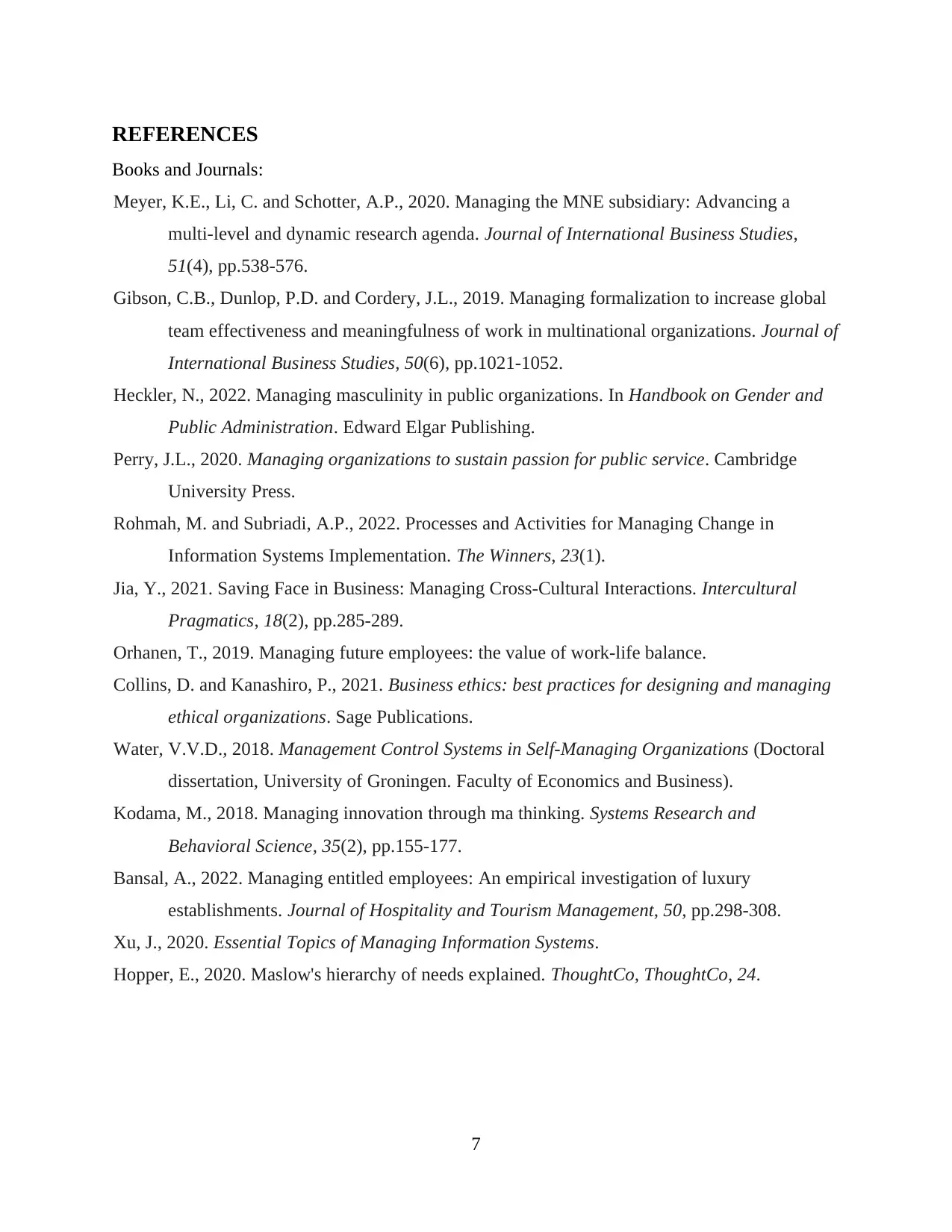
REFERENCES
Books and Journals:
Meyer, K.E., Li, C. and Schotter, A.P., 2020. Managing the MNE subsidiary: Advancing a
multi-level and dynamic research agenda. Journal of International Business Studies,
51(4), pp.538-576.
Gibson, C.B., Dunlop, P.D. and Cordery, J.L., 2019. Managing formalization to increase global
team effectiveness and meaningfulness of work in multinational organizations. Journal of
International Business Studies, 50(6), pp.1021-1052.
Heckler, N., 2022. Managing masculinity in public organizations. In Handbook on Gender and
Public Administration. Edward Elgar Publishing.
Perry, J.L., 2020. Managing organizations to sustain passion for public service. Cambridge
University Press.
Rohmah, M. and Subriadi, A.P., 2022. Processes and Activities for Managing Change in
Information Systems Implementation. The Winners, 23(1).
Jia, Y., 2021. Saving Face in Business: Managing Cross-Cultural Interactions. Intercultural
Pragmatics, 18(2), pp.285-289.
Orhanen, T., 2019. Managing future employees: the value of work-life balance.
Collins, D. and Kanashiro, P., 2021. Business ethics: best practices for designing and managing
ethical organizations. Sage Publications.
Water, V.V.D., 2018. Management Control Systems in Self-Managing Organizations (Doctoral
dissertation, University of Groningen. Faculty of Economics and Business).
Kodama, M., 2018. Managing innovation through ma thinking. Systems Research and
Behavioral Science, 35(2), pp.155-177.
Bansal, A., 2022. Managing entitled employees: An empirical investigation of luxury
establishments. Journal of Hospitality and Tourism Management, 50, pp.298-308.
Xu, J., 2020. Essential Topics of Managing Information Systems.
Hopper, E., 2020. Maslow's hierarchy of needs explained. ThoughtCo, ThoughtCo, 24.
7
Books and Journals:
Meyer, K.E., Li, C. and Schotter, A.P., 2020. Managing the MNE subsidiary: Advancing a
multi-level and dynamic research agenda. Journal of International Business Studies,
51(4), pp.538-576.
Gibson, C.B., Dunlop, P.D. and Cordery, J.L., 2019. Managing formalization to increase global
team effectiveness and meaningfulness of work in multinational organizations. Journal of
International Business Studies, 50(6), pp.1021-1052.
Heckler, N., 2022. Managing masculinity in public organizations. In Handbook on Gender and
Public Administration. Edward Elgar Publishing.
Perry, J.L., 2020. Managing organizations to sustain passion for public service. Cambridge
University Press.
Rohmah, M. and Subriadi, A.P., 2022. Processes and Activities for Managing Change in
Information Systems Implementation. The Winners, 23(1).
Jia, Y., 2021. Saving Face in Business: Managing Cross-Cultural Interactions. Intercultural
Pragmatics, 18(2), pp.285-289.
Orhanen, T., 2019. Managing future employees: the value of work-life balance.
Collins, D. and Kanashiro, P., 2021. Business ethics: best practices for designing and managing
ethical organizations. Sage Publications.
Water, V.V.D., 2018. Management Control Systems in Self-Managing Organizations (Doctoral
dissertation, University of Groningen. Faculty of Economics and Business).
Kodama, M., 2018. Managing innovation through ma thinking. Systems Research and
Behavioral Science, 35(2), pp.155-177.
Bansal, A., 2022. Managing entitled employees: An empirical investigation of luxury
establishments. Journal of Hospitality and Tourism Management, 50, pp.298-308.
Xu, J., 2020. Essential Topics of Managing Information Systems.
Hopper, E., 2020. Maslow's hierarchy of needs explained. ThoughtCo, ThoughtCo, 24.
7
⊘ This is a preview!⊘
Do you want full access?
Subscribe today to unlock all pages.

Trusted by 1+ million students worldwide
1 out of 9
Related Documents
Your All-in-One AI-Powered Toolkit for Academic Success.
+13062052269
info@desklib.com
Available 24*7 on WhatsApp / Email
![[object Object]](/_next/static/media/star-bottom.7253800d.svg)
Unlock your academic potential
Copyright © 2020–2025 A2Z Services. All Rights Reserved. Developed and managed by ZUCOL.





